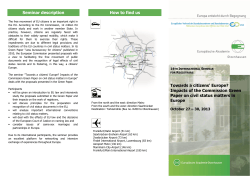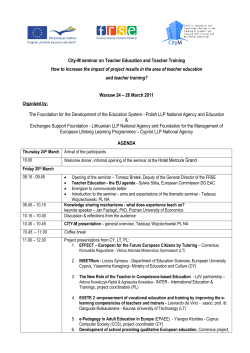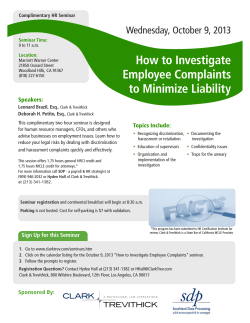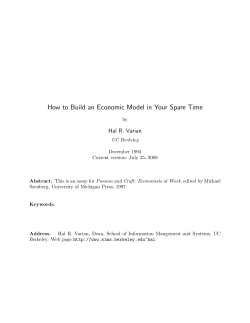
INTRODUCTION TO INNOVATION MANAGEMENT (INN001, 5 p.)
INTRODUCTION TO INNOVATION MANAGEMENT (INN001, 5 p.) INTRODUCTORY LECTURE August 27-28th 2007 Emelie Stenborg Today’s contents • Course outline • The role of innovation • What is innovation (definitions, typologies of innovation) • What is innovation management? • Models of the innovative process PEOPLE • Main teacher and course responsible: – Emelie Stenborg, 046-2223892, emelie.stenborg@circle.lu.se • Teachers in week 2 and 3: – Lars Coenen, 046-2227744, lars.coenen@circle.lu.se – Olof Ejermo, 046-2229650, olof.ejermo@circle.lu.se • Course secretary, matters of registration & administrative character: – Elna Jönsson, 046-2220576, elna.jonsson@circle.lu.se LOCATIONS Teaching the first three weeks mainly in the Math’s house Sölvegatan 18 The following 4 weeks in CIRCLE’s new location at Sölvegatan 16 (MNO-house) – Mondays 10-12: Lecture – Tuesdays 13-15: Lecture – Wednesdays/Thursdays 10-15: Seminar LOCATIONS MNO-house CIRCLE COURSE AIMS... (1) to provide students with fundamental knowledge of the phenomenon of innovation and innovation processes in capitalist economies from the perspective of firms and industries; (2) to enable students to use basic theoretical tools that help analyse and manage real-world processes of innovation; (3) to enhance students’ appreciation of the importance of understanding innovation-related issues for the development of businesses, industries, countries and citizens. WEEKLY THEMES 1. 2. 3. 4. 5. 6. Overview of the study field, with basic definitions, concepts and typologies, Chapter 1-2 Strategy analysis: I - building the framework and the environment, II - technology and learning, Chapter 3-6 The external dimension: markets, networks, institutions, systems, Chapter 7-8 Resource mobilization and strategy implementation, Chapter 9-10 Creating an innovative organisation, Chapter 11-12 Assessing and improving, Chapter 13 WEEK 1-5 • Mondays and Tuesdays: Lecture • Thursdays (one Wednesday): intensive seminar – The seminar is strongly compulsory – Active participation expected – Assignments to be handed in before the seminar – Seminar may include presentations etc. LAST 2 WEEKS • Sixth week: – Mainly reserved for writing the home exam. – One lecture on the Monday (and Tuesday if you need it) with room for questions. • Seventh week: – Examination – presentation and discussion in small groups (5-6 people) of the final essay (which is a part of the home exam). EXAMINATION Your progress and learning is assessed not only at the end of the course but throughout the entire course. Different forms of examination are used to gauge students’ progress: 1. Weekly written assignments in preparation for seminars 2. Formal presentations at seminars 3. Home exam, including final discussion seminar The home exam is the more important of the three. About the grading • The seminar assignments are not graded, but you have to hand them in – otherwise you will not get a grade on the course • The first part of the home exam determines half of your grade • The second half of the home exam determines the second half of the grade Home exam • The first part is a number of short questions relating to the course literature. These questions will be handed out on Monday of the sixth course week (October 1st) • The second part is a more open essay: students are asked to select a specific firm (or other organization) of their own choice and then relate the firm and its innovation activities to a number of more specific issues that have been taken up in the course literature and in teaching. Questions for the second part of the home exam • • • • • • • • • • • What types of innovation does the firm (not) concentrate on? Does it seem to be successful in its innovative activities? Why (not)? To which technological trajectory does the firm belong? How would you characterise the firm’s innovation strategy? What parts of the firm seem most important for innovation to be successful in the firm? Does the firm use external collaboration to enhance its innovations? If so, what types of collaboration, and why exactly those forms? And what types of partners? What type of competition is threatening the survival of the firm on the short and the long term? Does the firm use corporate ventures, and if so, of what type are they? In what stage of development is the industry in which the firm is active? What type of market (international?, local?, mass market?, niche market?) is at focus? Are there any institutional regulations or other political developments that are particularly important influencing the innovation activities of the firm? And how does the firm itself try to influence political developments? What is expected from you? You can choose between width and depth – answer several questions or just a few You are not expected to answer all questions – neither to do so in detail Specify the questions you are addressing 2 000 words per part – in sum 4 000 words (approximately 8 pages) A LTH grade is given U, 3, 4, 5 Note the following about plagiarism • Copying text from someone else without using quotation marks and citing the source is considered plagiarism. • For the home exam, there are no requirements of listing your references (however, this may show that you have found adequate resources), but you MUST USE quotation marks and list the source if you quote (you are not allowed to just copy text)! • If you violate this rule you may be reported! I will check for plagiarism. • If there is anything unclear about this, don’t hesitate to contact me Week Mon Tues Wed 1 27/8-31/8 Lecture 10-12 MH362D Lecture 13-15 MH362D Seminar 10-12 MH143 Seminar 13-15 MH229 2 3/9-7/9 Lecture 10-12 M:D Lecture 13-15 MH362D Lars Coenen Seminar 10-12 MH362A Seminar 13-15 MH362A 3 10/9-14/9 Lecture 10-12 MH362D Olof Ejermo Lecture 13-15 MH362D Seminar 10-12 MH362A Seminar 13-15 MH362A 4 17/9-22/9 Lecture 10-12 Lecture 13-15 Seminar 10-12 Seminar 13-15 5 25/9-29/9 Lecture 10-12 Lecture 13-15 Seminar 10-12 Seminar 13-15 6 1/10-5/10 Lecture 13-15 7 8/10-12/10 Examination 10-12 Examination 10-12 Examination 10-12 Thu Examination 10-12 Fri Examination 10-12 Course literature Managing Innovation Integrating Technological Market and Organizational Change 3ed Joe Tidd John Bessant Keith Pavitt ISBN 0470093269 Today’s contents • • • • • Course outline The role of innovation What is innovation? What is innovation management? Models of the innovative process Chapter 1: Key Concepts in Innovation Management The aim of innovation... • Depends on the type of firm • Goal is mostly to survive, to grow, to make profit • R&D departments generally strive for the best technical solution... • ... but what matters for innovation is how it influences survival chances, profit and growth opportunities! Innovation and the corporate strategy Innovation management..... • has to be understood as a core process of the organisation -> It is related to what is being produced • Is a long term race • Is about continuity • Has to deal with complexity!! • Is about being systematic developing routines around innovation WHAT IS INNOVATION? • • • • Invention Technology Innovation Creating new or improved products, processes and services • Knowledge and learning • Uncertainty Schumpeter’s distinction between ”Invention” and ”innovation” • An ’invention’ is an idea, a sketch or model for a new or improved device, product, process or system. It has not yet entered to economic system, and most inventions never do so. • An ’innovation’ is accomplished only with the first commercial transaction involving the new product, process, system or device. It is part of the economic system. Dimensions of Innovation the ‘4Ps’ of innovation – Product innovation: changes in the things (products or services) which an organization offers – Process innovation: changes in the ways in which they are created an delivered – Position innovation: changes in the context in which the product or services are introduced – Paradigm innovation: changes in the underlying mental modes which frame what an organization does According to the degree of codification: Information to tacit knowledge Wisdom Tacit Tacit knowledge Explicit Knowledge Information Data Codified Figure 1.1 Dimensions of innovation ©2005 Joe Tidd, John Bessant and Keith Pavitt Figure 1.4 Component and architectural innovation ©2005 Joe Tidd, John Bessant and Keith Pavitt The knowledge of innovation Knowledge product space Trade secrets Pr ow iva ne tely d Fully disclosed Di sc los ur e Shared expertise Property Source: David y Foray (1994) Scientific papers lic Codification Completely tacit Patents & copyrights Pu b Fully codifiable Restricted access Triggers of discontinuity • • • • • • • • • • • New market emerges New technology emerges New political rules emerge Running out of road Change in market sentiment or behaviour Deregulation or reregulation Fractures along ’fault lines’ Unthinkable events Business model innovation Shifts in techno-economic paradigm Architectural innovation Important contextual factors • • • • • Type of sector Size of firm The country and region The stage in the industry life cycle Political regulations Abernathy & Utterback – industry life cycles • The fluid phase – co-existence of old and new technologies – rapid improvement of both →’the sailing ship effect’ – Target: What product and what market? – Technical: What product who will produce it ? – Experimentation Important contextual factors • Globalisation • Sustainability • Networking organisation • The transitional phase – A dominant design • Convergence around one design • Rolling bandwagon → innovation channeled around a core set of possibilities → a technological trajectory – Imitation and development • Reliability, cheaply, higher functionality, quality • The specific phase – Rationalization & scale economies – Differentiation through customization – Scope for innovation becomes smaller Table 1.2 Stages in innovation life cycle ©2005 Joe Tidd, John Bessant and Keith Pavitt Three key questions 1. How do we structure the innovation process? 2. How do we develop effective routines? 3. How do we adapt or develop parallell routines to deal with incremental vs. discontinuous innovation? Conclusions • • • • Different kind of innovations Context specific Innovation has different stages Knowledge is the key Repetition Chapter 1 Four dimensions of innovation 1. Product, process, position, paradigm 2. System-Component 3. Incremental-New to the firm-Radical 4. Codified-Tacit Figure 1.4 Component and architectural innovation ©2005 Joe Tidd, John Bessant and Keith Pavitt Repetition Chapter 1 Innovation: • Depends on the type of firm, sector, industry life cycle, country and so on • Depends on the ”environment” • Goal is mostly to survive, to grow, to make profit • Technical solutions vs. societal and organisational aspects • Different from invention Innovation management • Core process • Production • Commercialisation – design, marketing, resources, competence • Long term • Continuity • Complexity • Systematic, routines New factors affecting innovation • Globalisation • Sustainability • Networking organisation Chapter 2: The innovation management process – Evolving models of the innovation process – Can we manage innovation? Introducing the concepts of Organizational Routines or Capabilities – Specify the different phases of the innovation process – How context affects innovation First and second generation models First generation (50’s-60’s): Technology push “Linear model” R&D DESIGN & ENGINEERING MANUFACTURING MARKETING SALES Second generation (mid 60’s-70’s): Demand pull MARKET NEEDS MARKETING DEPT. R&D MANUFACTURING SALES 3rd generation model Research Knowledge D Potential market K K Invent and/or produce analytic design I K Detailed design and test Redesign and product S Distribute and market : Direct link to and from research from problems in invention and design I : Support of scientific research by instruments, machines, tools S : Support of research in sciences underlying the product areas D 4th generation model marketing R&D Product development Components manufacture Product manufacture 4th generation model marketing R&D Product development Components manufacture Product manufacture Reduced time to market 5TH generation model University Financial System Suppliers IP INDUSTRY IP Government R&T Centres IP Users Innovation processes – generation model th 5 • Relevance of external sources of knowledge “firms do not innovate in isolation” • Related to Innovation System concept • Focus on networking • Still strong emphasis on R&D and formal knowledge (ICT) 6th generation of innovation processes “Revolve around knowledge and learning” • Networks embrace all knowledge types, not only R&D. • Most innovative firm is the one that learns fastest • It is the use of knowledge that makes the competitive difference, and creates the advantage Managing complexity product Radical Increment al Market R&D Networks Intellectual Capital processe s Innovation can come: – From the market (demand pull - 2nd) – From the “R&D department” (tech push - 1st ) – From any department (interactive – 3rd) – From process reinvention (integrated – 4th) – From external sources of information (networks - 5th) – From intangible assets (6th) Table 2.2 Rothwell’s five generations of innovation models ©2005 Joe Tidd, John Bessant and Keith Pavitt Innovation models SO, WHICH ONE IS RIGHT? • A fast food restaurant chain? • An electronic test equipment maker? • A hospital? • An insurance company? • A new entrant biotechnology firm? Can we manage innovation? • The majority of failures are due to some weakness in the way the innovation process is managed. • Technical resources (people, equipment, knowledge, money, etc.) • Capabilities in the organization to manage them • Organizational routines or capabilities are “the way we do things around here (in this organization)” as a result of repetition and reinforcement • Routines are firm-specific and must be learned. • “To manage” innovation means to create an organisation where routines can be learned as to cope with the complexity and uncertainty of the innovation process • Unlearning is important The innovation management process • Searching –looking for threats and opportunities for change within and outside of the organisation. – Technological opportunity – Changing requirements on the part of the market • Selecting – deciding (strategically from how the enterprise can develop and taking into account risk) what to respond to. – Flow of opportunities – Current technological competence – Fit with the current organizational competence • Implement – turn potential ideas into a new product or service, a change in process. – Acquiring – to combine new and existing knowledge (available within and outside the organization) to offer a solution to the problem – Executing – to turn knowledge into a developed innovation and a prepared market ready for final launch – Launching – to manage the initial adoption – Sustaining – to manage the long term use In the implementation phase • Cope with uncertainty about: – Technological feasibility – Market demand – Competitor behaviour – Regulatory and other influences • Replaced by knowledge accumulated → technology & market research • Learning – to learn from progressing through this cycle so that they can build their knowledge base and can improve the ways in which the process is managed. – Restart the cycle – Failure – why? – Refine, improvement → next generation – Learning about technology, routines & organization Figure 2.1 Simple representation of the innovation process ©2005 Joe Tidd, John Bessant and Keith Pavitt Almost the same - again Almost the same - again SCAN • Definition: – Detecting signals in the environment about potential change (market niches, technology development, etc) • Activities – Scanning environment for technological, market, regulatory and other signals – Collect and filter signal from background noise – Scan forward in time – Process signals into relevant information for decision making Almost the same - again FOCUS • Definition: – Selection of the various market and technological opportunities. • Inputs: – (1) the flow of signals coming from the previous phase – (2) the current technological base of the firm – (3) the fit with the overall business strategy. Almost the same - again RESOURCE • Definition: – Combining new and existing knowledge to offer a solution to the problem. • Activities: – – – – – Invent in-house through R&D activities Create the conditions for creativity Use existing knowledge in-house Technology transfer and knowledge transfer Licensing..etc Almost the same - again IMPLEMENT • Definition: – Close interaction between marketing related activities and technical activities to develop the idea into a marketable product or service. • Activities: – – – – – Develop to maturity Technical development Development of the market Launch After-sales support Almost the same - again LEARN • Definition – Analysing the failures and success to input the innovation process • Activities: – Continuous improvement – Knowledge and IC management “Innovation is a risky process....but also a mandatory one”. Success depends of a variety of: • Internal factors – – – – Good management Core competencies Clear innovation strategy Right technology • External factors – Links with market and suppliers – Learning from competitors – Institutional support: financing, human capital, etc Table 2.3 Problems of partial views of innovation ©2005 Joe Tidd, John Bessant and Keith Pavitt Table 2.3 Problems of partial views of innovation (continued) ©2005 Joe Tidd, John Bessant and Keith Pavitt Successful innovation • New products, processes and services account for an increasing share of sales – Lower prices – Better-performing products – Better features for certain users (niche) • ½ of resources devoted to the development of new products go to unsuccessful projects • 35% of products launched fail commercially Summary of Chapter 2 • • • • Models of the innovation process Routines and capabilities Innovation management process Partial views on innovation SEMINAR ASSIGNMENT WEEK 1 • Give examples from the real world of – a firm that has been successful at innovation – a firm that has failed to innovate successfully • What, would you say, might be the most important difference between the successful and the unsuccessful firm? • Please hand in half a page or one page or so, and bring a print-out of your answer with you to the seminar! • (The assignment will not be graded, but you have to bring it with you to the seminar in order to participate!) How to select firms • See separate sheet for guidelines • You could: a) Follow one firm over the entire course - Of course, you should be able to cover many aspects of innovation using this case b) ...or switch firm based on the assignment - Note! Doing this too often may take a lot of time! • • You don’t have to decide now... ...however, a recommended strategy is that you choose case(s) with enough ’richness’ to cover several aspects of innovation
© Copyright 2024









